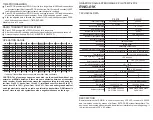
WATLOW Series 945 User's Manual
Appendix
39
Alarm: A condition, generated by a controller,
indicating that the process has exceeded or dropped
below a predetermined alarm set point.
Alarm Silence: Disables the alarm relay output.
Anti-reset: Control feature that inhibits automatic
reset action outside the proportional band. Also
known as "reset windup inhibit."
Automatic prompts: Data entry points where a
microprocessor-based control "prompts" or asks the
operator/programmer for information input.
Auto-tune: Automatically tunes the Series 945 PID
parameters to fit the characteristics of your particular
thermal system.
Bumpless transfer: When transferring from auto to
manual operation, the control output(s) will not
change ("bumpless," smooth transition).
Closed loop: Control system that has a sensing
device for process variable feedback.
Cold junction: Point of connection between thermo-
couple metals and the electronic instrument.
Cold junction compensation: Electronic means to
compensate for the ambient temperature at the cold
junction.
Cycle time: The time necessary to complete a full
ON-through-OFF period in a time proportioning
control system.
Data Logging: A convenient replacement for chart
recorders. Information is sent from the 945 to a
serial printer. Provides a handy reference to review
process performance.
Dead band: A temperature band between heating
and cooling functions.
Derivative: Anticipatory action that senses the rate
of change of the process, and compensates to
minimize overshoot and undershoot. Also "rate."
Deviation alarm: An alarm referenced at a fixed
number of degrees, plus or minus, from set point.
Glossary, A-J
Default parameters: The parameters permanently
stored in memory to provide a data base.
DIN: Deutsche Industrial Norms, a widely-recog-
nized German standard for engineering units.
Droop: Difference in temperature between set point
and stabilized process temperature.
Duty cycle: Percentage of "load ON time" relative to
total cycle time.
Form A: Single Pole Single Throw relay that only
utilizes the N.O. and Common contacts. These
contacts close when the relay coil is energized. The
contacts open when power is removed from the
control.
Form B: Single Pole Single Throw relay that only
utilizes the N.C. and Common contacts. These
contacts will open when the relay coil is energized.
The contacts will close when power is removed from
the control.
Form C: Single Pole Double Throw. Utilizes the
N.O., N.C. and Common contacts. The user has the
option of wiring for a Form A or Form B contact. Re-
fer to Form A & Form B above for more information.
Hysteresis: In ON/OFF control, the temperature
change necessary to change the output from full OFF
to full ON again.
Hunting: Oscillation or fluctuation of process
temperature about the set point.
Input: Process variable information being supplied
to the instrument.
Integral: Control action that automatically eliminates
offset, or “droop,” between set point and actual
process temperature. Also "reset."
Isolation: Electrical separation of sensor from high
voltage circuitry. Allows for application of grounded
or ungrounded sensing element.
JIS Japanese Industrial Standards. Also Japanese
Industrial Standards Committee (JISC). Establishes
standards on equipment and components.






































